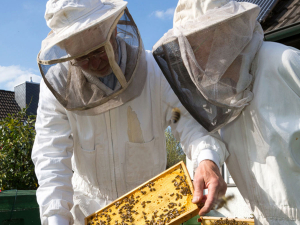Planting to feed the bees
The Ministry for Primary Industries (MPI) have released a handbook offering guidance on how to plant strategically to feed bees.
 Supermarkets have cut the price paid to suppliers, but haven’t cut the price on the shop shelf, claims Lorimer.
Supermarkets have cut the price paid to suppliers, but haven’t cut the price on the shop shelf, claims Lorimer.
Supermarkets have put the squeeze on beekeepers who supply them, claims Jane Lorimer, NZ Beekeeping president.
They have cut the price paid to suppliers, but haven’t cut the price on the shop shelf. So consumers still see honey as really expensive.
“We have cut back but the supermarkets are making more money out of their product. We definitely had the squeeze put on us ‘drop your price or you are out’.”
Head of corporate affairs, Foodstuffs NZ, Antoinette Laird, told Rural News there is currently an over-supply of non-manuka honey varieties in the market which has softened retail prices.
“This is great for shoppers who benefit as honey prices drop - but we do recognise this common supply and demand outcome challenges the supplier community,” she says.
“Last year 500g of Pams Clover Creamed Honey retailed at $12.49 and today costs $6.99 at New World, while Airborne Honey Liquid 500g, which retailed $12.19 in 2019 is now on-shelf at $7.99 – making New Zealand produced honey a very affordable option for more of our customers.”
A Countdown supermarket spokesperson told Rural News the price of honey spiked a couple of years ago and it’s now coming back down due to the changed manuka regulations and an over-supply of clover and blended honeys.
“Our honey prices have dropped about 15% in the last year. Previously the high honey prices meant it was becoming too expensive for customers to choose honey as a spread or ingredient, but we’re starting to see honey sales pick up again now that it’s more affordable for customers.”
The Coalition Government will need the support of at least one opposition party to ratify the free trade deal with India.
Primary sector leaders have welcomed the announcement of a Free Trade Agreement between India and New Zealand.
At Pāmu’s Kepler Farm in Manapouri, mating has wrapped up at the across-breed Beef Progeny Test.
More than 150 people turned up at Parliament recently to celebrate the 20th anniversary of Horticulture New Zealand (HortNZ).
Biosecurity New Zealand says Kiwis should continue to keep an eye out for yellow-legged hornets (Vespa velutina) over the holiday season.
Fonterra has slashed another 50c off its milk price forecast as global milk flows shows no sign of easing.

OPINION: The release of the Natural Environment Bill and Planning Bill to replace the Resource Management Act is a red-letter day…
OPINION: Federated Farmers has launched a new campaign, swapping ‘The Twelve Days of Christmas’ for ‘The Twelve Pests of Christmas’ to…